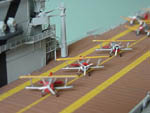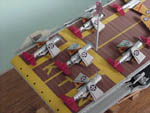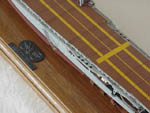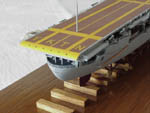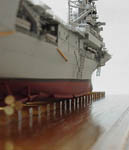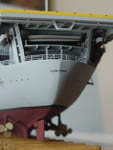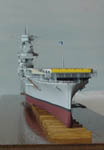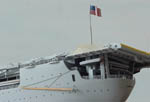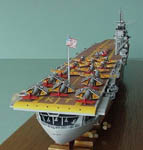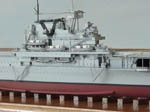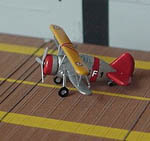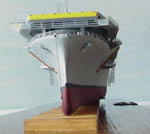USS Yorktown CV-5
Revell 1/480
By: Stephen Allen

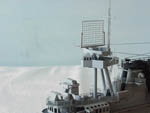 This
build represents the Yorktown in her appearance during October/November 1940.
This was after the fitment of CXAM radar, and represents the ship's penultimate
appearance in peacetime paint. Installation of the CXAM took place at the Pearl
Harbor Navy Yard and involved removing the four 0.50 cal guns carried in the
foretop - these were refitted (in tubs at the ends of the flightdeck catwalks)
at the end of November, just before Yorktown joined the Atlantic Fleet.
This
build represents the Yorktown in her appearance during October/November 1940.
This was after the fitment of CXAM radar, and represents the ship's penultimate
appearance in peacetime paint. Installation of the CXAM took place at the Pearl
Harbor Navy Yard and involved removing the four 0.50 cal guns carried in the
foretop - these were refitted (in tubs at the ends of the flightdeck catwalks)
at the end of November, just before Yorktown joined the Atlantic Fleet.
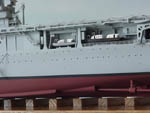 The
colour scheme is the pre-war carrier scheme of standard navy gray on all vertical
surfaces, mahogany-stained flight deck with yellow markings, and
The
colour scheme is the pre-war carrier scheme of standard navy gray on all vertical
surfaces, mahogany-stained flight deck with yellow markings, and 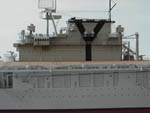 deck
gray on most of the steel decks. Exceptions to the latter include overall standard
navy gray for the flight deck catwalks and black rubber matting around the 5/38cal
and 0.50 cal guns. The ship carries a prominent black 'Y' as an identification
marking down each side of the funnel casing. Both the standard navy and deck
gray are WEM colourcoat paints, while the 'mahogany' flight deck, yellow markings
and black areas are various tints of Humbrol. The bottom paint is Floquil marine
antifouling red.
deck
gray on most of the steel decks. Exceptions to the latter include overall standard
navy gray for the flight deck catwalks and black rubber matting around the 5/38cal
and 0.50 cal guns. The ship carries a prominent black 'Y' as an identification
marking down each side of the funnel casing. Both the standard navy and deck
gray are WEM colourcoat paints, while the 'mahogany' flight deck, yellow markings
and black areas are various tints of Humbrol. The bottom paint is Floquil marine
antifouling red.
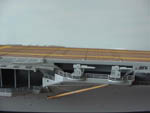 I
built the Yorktown using Loren Perry's excellent Gold Medal Models etch sheet
designed specifically for this kit. The sheet is designed to be used with the
I
built the Yorktown using Loren Perry's excellent Gold Medal Models etch sheet
designed specifically for this kit. The sheet is designed to be used with the
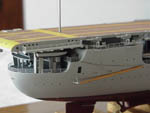 standard
kit and if you make changes to improve accuracy you will also need to modify
some of the etched parts. In this case the railing around the stern needed to
be cut to fit the new flight deck supports, the boat crane beside the island
was cut down to tuck under the bridge platform, and I removed a few mm from
the base of each of the hangar deck cranes so they would fit under the flight
deck catwalks.
standard
kit and if you make changes to improve accuracy you will also need to modify
some of the etched parts. In this case the railing around the stern needed to
be cut to fit the new flight deck supports, the boat crane beside the island
was cut down to tuck under the bridge platform, and I removed a few mm from
the base of each of the hangar deck cranes so they would fit under the flight
deck catwalks.
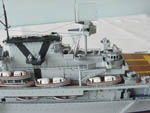 I
scratchbuilt the island, funnel casing and tripod foremast, incorporating the
appropriate GMM etched parts - the kit supplied island is woefully inaccurate
for ANY of the CV-5 class kits. I didn't fit the small cabin on the sky control
level
I
scratchbuilt the island, funnel casing and tripod foremast, incorporating the
appropriate GMM etched parts - the kit supplied island is woefully inaccurate
for ANY of the CV-5 class kits. I didn't fit the small cabin on the sky control
level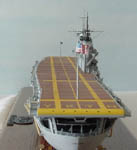 shown in some 1940 photos of Yorktown, as I'm not convinced it was there for
very long - I hedged my bets by building one but leaving it unattached. I also
cut off the section of the port side of the hull between the hangar and flight
deck and built up a sandwich of smooth and grooved plastic card to better depict
the closed roller shutters. The characteristic flight deck support bents fore
and aft were also built up from scratch, as the kit only provides single and
inaccurately located
shown in some 1940 photos of Yorktown, as I'm not convinced it was there for
very long - I hedged my bets by building one but leaving it unattached. I also
cut off the section of the port side of the hull between the hangar and flight
deck and built up a sandwich of smooth and grooved plastic card to better depict
the closed roller shutters. The characteristic flight deck support bents fore
and aft were also built up from scratch, as the kit only provides single and
inaccurately located  supports
in these locations. Other 'homemade' additions include additional motor launches
and open topped Mk 33 Directors moulded from resin, new 5/38 mounts built up
on the GMM supplied bases, and lots of additional detail around the hangar deck
galleries and the forecastle and stern areas, including some representative
supporting structure to the underside of the flightdeck catwalks and overhang
fore and aft. I even went mad and put some girder detail inside the opened hangar
bays fore and aft. Flags are courtesy of Dunagain Decals, and are flying from
the telescopic navigation masts fitted to this class of ship.
supports
in these locations. Other 'homemade' additions include additional motor launches
and open topped Mk 33 Directors moulded from resin, new 5/38 mounts built up
on the GMM supplied bases, and lots of additional detail around the hangar deck
galleries and the forecastle and stern areas, including some representative
supporting structure to the underside of the flightdeck catwalks and overhang
fore and aft. I even went mad and put some girder detail inside the opened hangar
bays fore and aft. Flags are courtesy of Dunagain Decals, and are flying from
the telescopic navigation masts fitted to this class of ship.
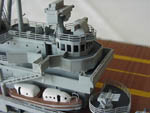
My representative 1940 airgroup includes Northrop BT-1s, converted  from
the kit-supplied SBDs, homemade Grumman F3F fighters, and Douglas TBDs, in resin
from White Ensign. The three-bladed props and wheels are from the Gold Medal
Models etched sheet for Yorktown, while all the other small details are from
White Ensign sheets. Thanks are due to all the SMMLies who responded to my post
earlier this year about techniques for painting aircraft canopies on small aircraft.
from
the kit-supplied SBDs, homemade Grumman F3F fighters, and Douglas TBDs, in resin
from White Ensign. The three-bladed props and wheels are from the Gold Medal
Models etched sheet for Yorktown, while all the other small details are from
White Ensign sheets. Thanks are due to all the SMMLies who responded to my post
earlier this year about techniques for painting aircraft canopies on small aircraft.
|
|
|
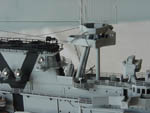 |
 |
Copyright © SMML 2002

 This
build represents the Yorktown in her appearance during October/November 1940.
This was after the fitment of CXAM radar, and represents the ship's penultimate
appearance in peacetime paint. Installation of the CXAM took place at the Pearl
Harbor Navy Yard and involved removing the four 0.50 cal guns carried in the
foretop - these were refitted (in tubs at the ends of the flightdeck catwalks)
at the end of November, just before Yorktown joined the Atlantic Fleet.
This
build represents the Yorktown in her appearance during October/November 1940.
This was after the fitment of CXAM radar, and represents the ship's penultimate
appearance in peacetime paint. Installation of the CXAM took place at the Pearl
Harbor Navy Yard and involved removing the four 0.50 cal guns carried in the
foretop - these were refitted (in tubs at the ends of the flightdeck catwalks)
at the end of November, just before Yorktown joined the Atlantic Fleet.








